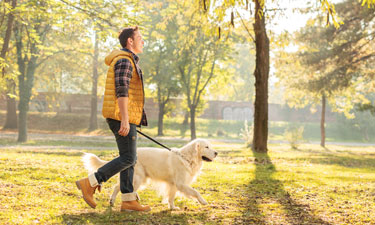 The obesity epidemic in the United States sadly is not confined to humans. According to the American Veterinary Medical Association (AVMA), almost 53 percent of dogs and 58 percent of cats in the United States are considered overweight or obese. It seems our furry friends are in as great a need of regular exercise as the almost 70 percent of U.S. adults diagnosed as overweight or obese.
The obesity epidemic in the United States sadly is not confined to humans. According to the American Veterinary Medical Association (AVMA), almost 53 percent of dogs and 58 percent of cats in the United States are considered overweight or obese. It seems our furry friends are in as great a need of regular exercise as the almost 70 percent of U.S. adults diagnosed as overweight or obese.
Where those populations overlap, however, there is room for healthy improvements. Experts point to decreased blood pressure and more successful fitness outcomes among dog owners, versus those without a canine walking companion. Research published in the Journal of Physical Activity and Health showed dog owners were more likely to reach their fitness goals — meanwhile, researchers at Michigan State University found that dog owners are 34 percent more likely to fit in the recommended 150 minutes of walking per week than non-dog owners.
Pet Park Prescriptions
Park Prescriptions for humans — the practice of physicians prescribing time outdoors, often in local parks, as therapy for various ailments — is quickly catching on across the country. Doctors and other public health providers are taking note that parks exist in almost every neighborhood, are largely free to use and already feature the types of amenities that get people up and active, like walking and cycling trails. Now, veterinarians are beginning to catch on, melding existing research like that cited above with the convenient availability of local parks. “As a veterinarian, I know that people [aren’t the only ones] grappling with the consequences of underactivity, such as diabetes and heart and respiratory disease,” Dr. Joseph Kinnarney, a mixed-animal practitioner in Reidsville, North Carolina, and president of the Reidsville Veterinary Hospital, said during his April remarks to announce AVMA’s support of U.S. Surgeon General Vivek Murthy’s “Step It Up!” campaign. “I see the results of our sedentary lifestyles every day in my veterinary patients. The good news is that by making small positive changes in our daily lives — like taking the opportunity for a short walk with our pets — we can improve our health together.”
It makes perfect sense that veterinarians would align their patients’ goals with those of Step It Up! — the program encourages brisk walking to reduce the risk of heart disease and diabetes in people, but, when a leashed dog is added to the mix, positive health outcomes realized by human walkers naturally extend to their four-legged friends. “The AVMA is so happy to join with the National Park Service and the Surgeon General’s Office in urging the public to Step It Up!” Kinnarney said. “Walking benefits the physical and mental health of people and their pets. Walking is a way to promote health and prevent disease and is accessible, cost-effective and can be customized to you and your pet.”
Walking to Promote Baseline Health
It’s important to remember that dogs require regular walks for a healthy life, whether or not they’re battling weight problems. According to the U.S. Centers for Disease Control and Prevention, so do humans! Adults between the ages of 18 and 64 need at least 150 minutes of moderate to vigorous physical activity each week just to maintain good physical health. Compounding problems like obesity, diabetes and heart disease only underline the necessity of regular exercise for all species.
“Is there really any better way to honor your pet than to commit to a healthy lifestyle for both of you?” Kinnarney asked. To that end, AVMA has added simple guidelines and tips to its website, designed to help pet owners develop an exercise regimen that works both for their dog and themselves. “Give it a try and see if you don’t both feel better,” Kinnarney urged.
Samantha Bartram is the Executive Editor of Parks & Recreation magazine.
Resources
The American Veterinary Medical Association offers several tips and precautions to consider when developing a walking regimen with your dog:

